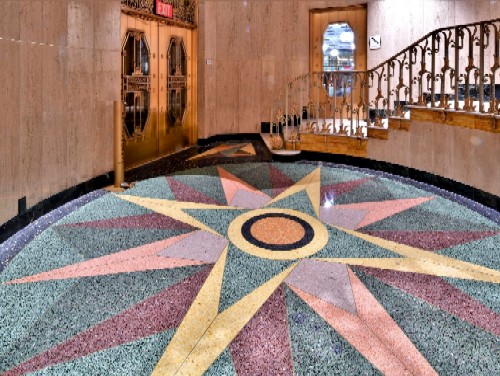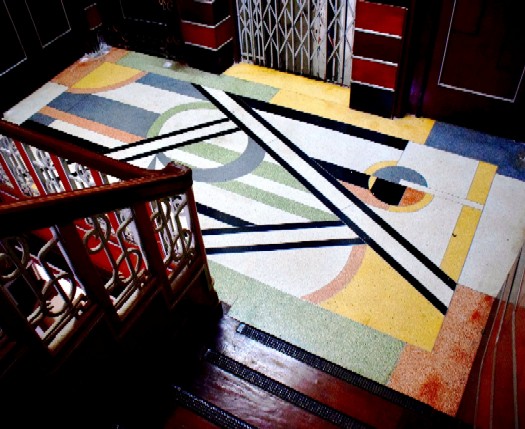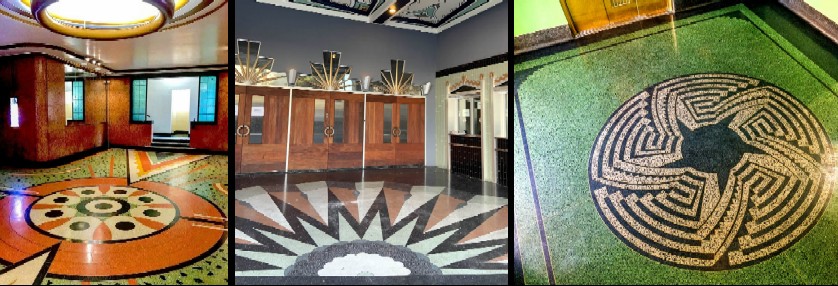
Material - Terrazzo Floors
Terrazzo is a decorative finish made by combining

Terrazzo Floor, Bottleworks Hotel, Indianapolis, Indiana, 1931, North Central Terrazo Assn
chips of durable material - marble, granite, quartz, shells and glass - with a binding material - cement or epoxy resin. The mixture is poured in place and then ground to reveal the pattern created by the chips. The result is highly customizable based on the binding material and types and colors of chips chosen. The resulting finish is extremely tough and can be customized to fit in a variety of shapes.
While the art of terrazzo is ancient, dating to mosaics created in ancient Egypt, its use as a floor material is much more modern, first appearing in 15th century Venice, Italy. "Venetian artisans of the time began to take the discarded chips from marble slabs and imbed them into concrete mixtures. They would then grind down the surface for their own terraces and other living spaces – hence the term, 'terrazzo' – which is the Italian term for 'terrace'." ("The History & Art of Terrazzo", The Tileist, Gathered 9/8/24)
Terazzo floors first appeared in the United States in the Vanderbilt home in New York in 1890. Italian families brought the terrazzo floor technique with them when they immigrated to the US. "The United States had a wealth of marble thus creating an opportunity for terrazzo to flourish at the turn of the century. ...terrazzo gained more recognition during the 1920s as Art Deco styles rose in popularity." (Concord Terazzo History, "Art Deco Terrazzo in 1920s United States", Terrazzco, Gathered 9/8/24)
A number of innovations occurred in the first half of the 1920s which made terazzo easier and cheaper to install which helped ignite the terrazzo floor craze of the Art Deco and Streamline Moderne period. In 1924, the

Terrazo Floor, Court View - Rusi Court, Mumbai, Photo - Atul Kumar, c. 1935-40,
Art Deco Mumbai on X
electric grinder was invented which produced a finer finish and allowed grinding to occur with greater speed and accuracy. The same year, L. Del Turco and Bros. invented divider strips which allowed the material more space to expand and shrink after installation and prevented cracking. It also allowed for the use of more creative border shapes including Streamline friendly curves. Portland cement was discovered to be an effective binding agent during the 1920s, having the added benefit of allowing different colors to be added to the bonding agent, expanding the design possibilities for terrazzo floors.
The popularity of the material was indicated by the creation of the National Terrazzo and Mosaic Contractors Association in Chicago, Illinois by Gus Cassini in 1923. The organization's name was changed to The National Terrazzo and Mosaic Association in 1929. The NTMA set standards and best practices for installing terrazzo. Today they still host seminars to share technical knowledge, techniques and examine trends in the field. Some of the modern examples found below are from examples of such seminars.
"By the end of World War I, terrazzo fit perfectly into the new modern and Art Deco design movements and its popularity began to grow along with modern installation techniques and better material technologies. Terrazzo was now the material of choice for many signature buildings of the early 20th century, including the Empire State Building and Radio City Music Hall." (The Tilest)
Sources Not Mentioned Above:
"That Classic Terrazzo - The Old, new and Now!", Bharat Floorings website, Gathered 9/8/24
"History of Terrazzo", The National Terrazzo & Mosaic Association, Gathered 9/8/24
"Terrazzo", Wikipedia, Gathered 9/8/24
Original Facebook Group Posting
 Terrazzo Floors, From left - Fish Building, New York, 1937, Instagram; Saban Theater, Beverly HIlls, 1927, Pinterest; Hoover Dam, Women's Lobby, 1936, Cruising at 60
Terrazzo Floors, From left - Fish Building, New York, 1937, Instagram; Saban Theater, Beverly HIlls, 1927, Pinterest; Hoover Dam, Women's Lobby, 1936, Cruising at 60